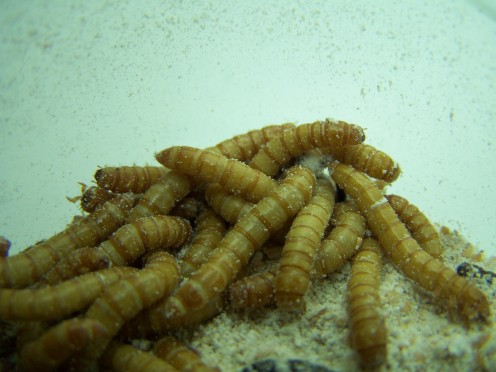How to Breed and Raise Mealworms Successfully

Breeding mealworms for your chickens or reptiles is easy. It is inexpensive and they reproduce quickly. Why not give breeding your own mealworms a try?
My upcoming E-book will go into detail on how to raise super nutritious mealworms and red wigglers for your livestock and for profit.
© Copyright Notice ©
My photographs are mine, taken by me, with my camera. You may use them for personal reasons (desktop backgrounds, personal websites or you can print them for personal use.)
If you choose to use them on websites I require a link back to my HubPages. You may link to my profile or to one of my Hubs.
You may not use them without my permission or for profit.
I sell my art and if you are interested in purchasing it send me a message.
ALL of my articles are MINE and you may NOT use them for anything but reading on my page.
Buy A lot, Once.
I recommend starting out with five-hundred to one-thousand mealworms. This will give you very quick results when you're after large numbers of larvae.
Mealworms are pests. If they manage to escape, it is possible to get them into your grains. They will spoil your stored food so make sure your beetles and larvae cannot escape their breeding areas. They don't really fly so as long as they cannot climb the walls, you should be fine!
It will take a good while before you see the young mealworms. They are super tiny and are easily looked over. Don't worry, as long as their container is warm and they have food, they will lay their eggs and make lots of babies!
Feed Them Well
A good mealworm mixture would be barley and oats with a sprinkle of yeast. Someone people grind the grains into a powder, I just add them whole and let the mealworms eat them before adding more.
A moisture source can be made of carrots, apples, bananas, potatoes, or any other moist fruit/veggies. Replace anything that begins to mold.
Mealworm Container
I use plastic containers for my small operation. If you're just feeding a few small animals, that is all you need. My E-book will go into detail on how to raise mealworms on a larger scale for livestock and for profit.
The Sterilite brand containers from Walmart work well.
Poke a few holes in the lid for ventilation.
Add about one or two inches of grain to the container and then plop your mealworms in.
Put a piece of plastic (a piece of plastic shopping bag works great) in the container. Place your moist food on top of this plastic. Your mealworms will congregate beneath the plastic and make it easy to harvest them. The plastic also keeps the grains from molding.
Humidity keeps the mealworms happy and mine seem to molt much better when the humidity is higher. If things start to mold, remove the lid and allow the container to dry out a bit.
*Cook the grains before adding them to the container. Freezing weather did NOT kill the meal mites in my contaminated grain.* Now I put some grain in a pot and cook it dry on the stove. I cook it, stirring for a few minutes to ensure nothing is alive. Then I cool it down and add it to the mealworms.
Place the mealworms in a dark place that stays in the 70's. Warm weather encourages the mealworms to breed. Too cold and they will stop breeding. Mine have gone through freezing temperatures outside and lived. After several months, the beetles died but the larvae are still alive. They just don't grow and turn into beetles in cold weather.
Harvesting your Mealworms
I use a kitchen sifter to remove the mealworms. I pick up a gob and then shake the substrate over a bowl. I am left with beetles and larvae. This is a simple way to do it. I do not feed my beetles to the animals. I pick them out and let them keep breeding.








